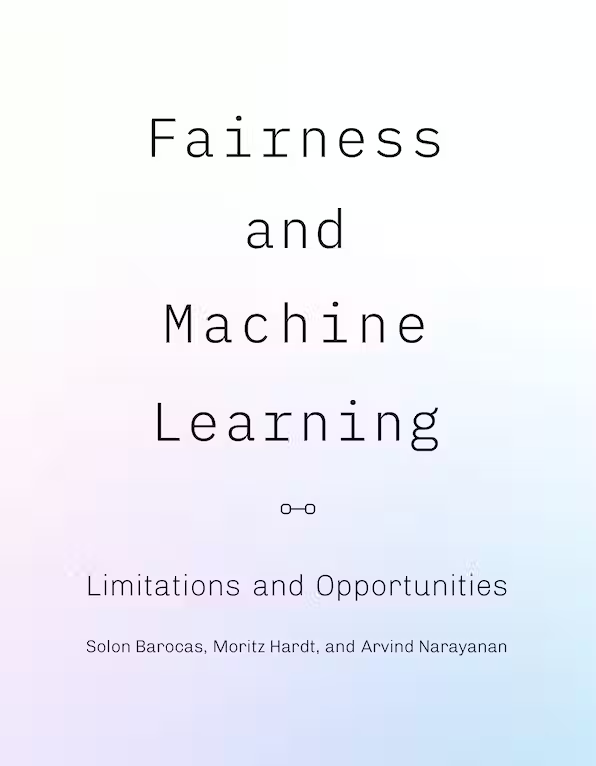Fairness and machine learning
Limitations and Opportunities
Solon Barocas, Moritz Hardt, Arvind Narayanan

The book has been published.
A PDF of the full book is available.
| CONTENTS | ||
| Preface | ||
| Acknowledgments | ||
| 1 | Introduction | |
| 2 | When is automated decision making legitimate? | |
| We explore what makes automated decision making a matter of normative concern, situated in bureaucratic decision making and its mechanical application of formalized rules. | ||
| 3 | Classification | |
| We introduce formal non-discrimination criteria in a decision-theoretic setting, establish their relationships, and illustrate their limitations. | ||
| 4 | Relative notions of fairness | |
| We explore the normative underpinnings of objections to systematic differences in the treatment of different groups and inequalities in the outcomes experienced by these groups. | ||
| 5 | Causality | |
| We dive into the technical repertoire of causality and how it helps articulate and address shortcomings of the classification paradigm, while raising new conceptual and normative questions. | ||
| 6 | Understanding United States anti-discrimination law | |
| We discuss what United States anti-discrimination law is and isn’t, how it navigates tradeoffs, its limits, and how it applies to machine learning. | ||
| 7 | Testing discrimination in practice | |
| We systematize tests of discrimination and discuss the practical complexities of applying them, both to traditional decision-making systems and to algorithmic systems. | ||
| 8 | A broader view of discrimination | |
| We review structural, organizational, and interpersonal discrimination in society, how machine learning interacts with them, and discuss a broad set of potential interventions. | ||
| 9 | Datasets | |
| Datasets are the backbone of machine learning research and development. We critically examine their role, the harms associated with data, and survey improvements in data practices. | ||
| Exercises and Discussion Prompts | ||
| We provide an online-only set of exercises and discussion prompts on a range of topics covered throughout the textbook. | ||
Video tutorials
- Fairness and Machine Learning (Part 1, Part 2) (MLSS 2020)
- Fairness in machine learning (NeurIPS 2017)
- 21 fairness definitions and their politics (FAccT 2018)
Course materials
Contact us
We welcome your feedback, questions, and suggestions. You can reach us at contact@fairmlbook.org. If you taught from the book, we’d love to hear about it.
Citations, license, typesetting
To cite this book, please use this bibtex entry:
@book{barocas-hardt-narayanan,
title = {Fairness and Machine Learning: Limitations and Opportunities},
author = {Solon Barocas and Moritz Hardt and Arvind Narayanan},
publisher = {MIT Press},
year = {2023}
}
A hardcover print edition has been published by MIT Press in 2023.
The text available on this website is licensed under the Creative Commons BY-NC-ND 4.0 license.
Last updated: Fri Nov 10 22:36:26 CET 2023